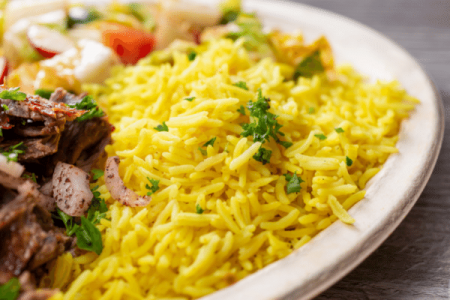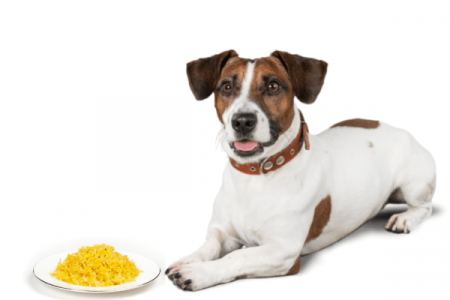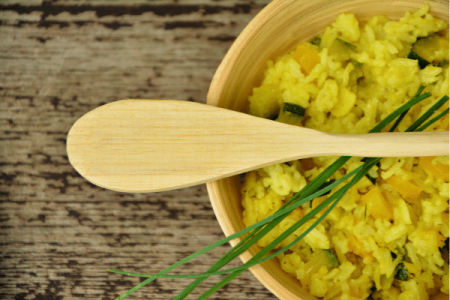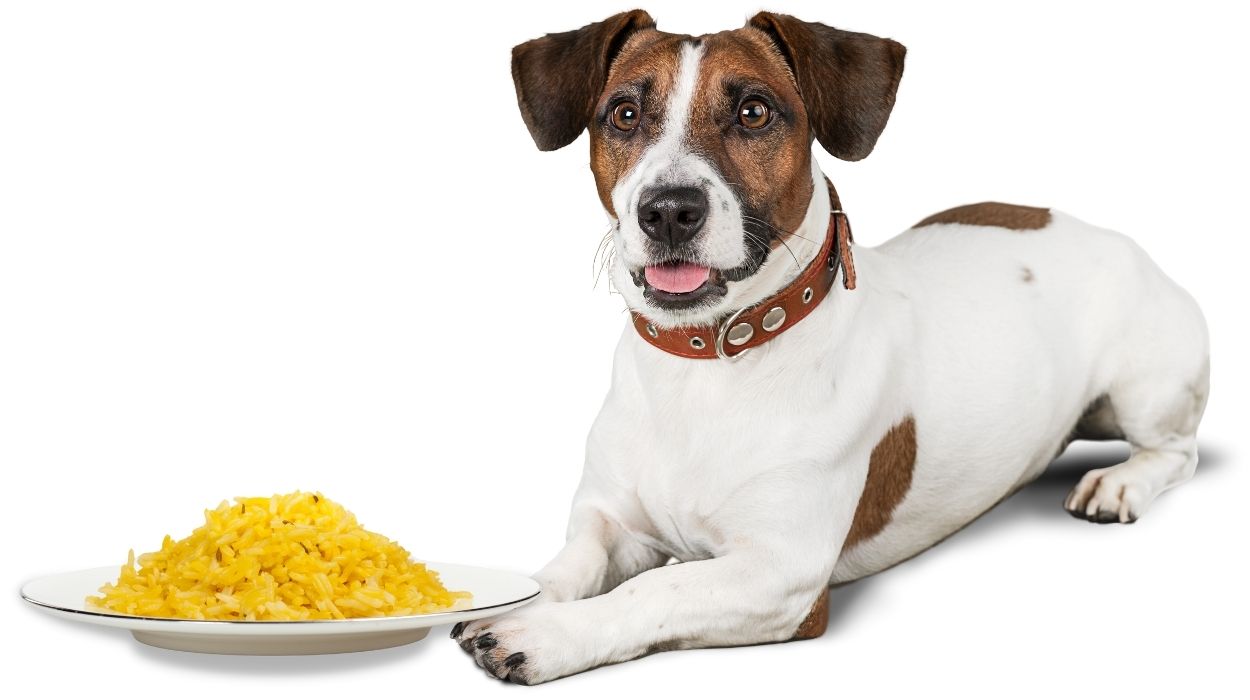Everyone likes a finger-licking serving of yellow rice occasionally. Did you know yellow rice called Tumpeng is served in traditional Indonesian ceremonies?
Do you often share your regular meals with your four-legged furry pal? Are you thinking about offering some yellow rice to your dog? Are you concerned whether it would be safe for him or not?
We will delve deep into the pros and cons of feeding yellow rice to your pooch. In this article, we’ll talk about the core ingredients of yellow rice along with its suitable quantity for your dog.
What are the ingredients used in yellow rice?

Apart from rice, this delicacy consists of three primary condiments:
1. Turmeric
The quantity of turmeric that is generally used while cooking is considered safe for dogs. Turmeric is very beneficial for dogs as it is an antioxidant as well as an anti-inflammatory drug.
However, you must make sure that your dog does not end up eating large amounts of turmeric. Around 15-20 mg of turmeric for each pound of your doggo’s body weight is considered suitable for him.
Just like humans, even dogs can demonstrate intolerance to turmeric. Thus, you must constantly monitor your dog’s physiological and behavioral reactions if you’re giving him turmeric for the first time.
2. Saffron
The amount of saffron usually used in making yellow rice is not harmful to dogs. Saffron is a very beneficial natural ingredient for your dog if consumed in minimal amounts.
However, saffron could prove quite toxic to dogs if consumed in large amounts. You must consult your vet before incorporating saffron into your dog’s diet.
3. Annatto
Annatto is a widely prevalent spice used in the preparation of yellow rice. Along with its slightly sweet and spicy taste, Annatto is known for its health benefits in certain eye and skin-related problems.
Your dog will not have any adverse effects if he consumes a minuscule quantity of Annatto. However, its consumption in large amounts can have several side effects. These include:
-
Itchiness
Rashes
Swollen joints
Hives
Stomach pains
Swelling
Low blood pressure (hypotension)
Therefore, annatto is not generally recommended for dogs.
What are the risks of Yellow rice for your dog?

As mentioned earlier, eating yellow rice in large amounts would result in adverse health conditions. Some risks posed to your dogs due to excessive consumption of yellow rice are as follows:
-
Apart from saffron and turmeric, yellow rice contains certain other seasonings and spices that are unsafe for your dog’s consumption. These include cloves, shallots, chives, ginger, scallions, etc. If they enter a dog’s system in large amounts, they are bound to cause adverse reactions in him.
Other core components of yellow rice, namely onions and garlic, are incredibly toxic to dogs. Their consumption in large amounts could induce hemolytic anemia.
Hemolytic anemia is a severe condition in dogs that causes severe damage to red blood cells (RBCs). This subsequently leads to a decrease in the number of RBCs in your dog’s body.
Medical research has determined that Annatto can cause hypoglycemic episodes in dogs. Herein, the dog is likely to experience abnormally low levels of blood sugar in his body.
Warning: If your dog eats up yellow rice in generous amounts, he is bound to experience hemolytic anemia and hypoglycemic episodes. This can be fatal for him if not promptly treated.
What are the benefits of yellow rice for your dog?

Well, it is not all cons in the case of yellow rice. We present to you some of the health benefits that your dog can get from moderate consumption of yellow rice:
-
Dogs suffering from digestive issues will get a lot of relief from eating yellow rice. With its high potassium content, yellow rice increases your dog’s appetite by helping him break down proteins and lipids.
Turmeric not only soothes your dog’s upset tummy but also decreases the pain caused by joint inflammation or arthritis.
Yellow rice strengthens your dog’s kidneys and helps restore them to their original state if they were contaminated.
The soluble fibers in yellow rice are very beneficial if your dog is experiencing diarrhea. It lowers his PH levels and helps the absorption of water in the gut.
Author’s Note: You can cook some pieces of pumpkin along with yellow rice. A normal and firm stool would result from this diet as rich fibers would enter your dog’s body.
FAQs
Q. What are the alternatives to yellow rice for dogs?
There are multiple alternatives to yellow rice for your dog:
-
Plain cooked white or brown rice (latter is best for weight loss)
White rice and boiled chicken (for dogs who are ill and require a bland diet)
Plain cooked white rice mixed with commercial dog food
Boiled brown rice with boiled egg
Boiled white rice with plain boiled boneless chicken, pork, or beef
Q. Can you feed yellow rice to your puppy?
Yes. Moderate amounts of yellow rice fed once in a while is absolutely safe for your puppy. However, make sure not to overfeed him as puppies have a super-sensitive stomach that might suffer from digestive issues and diarrhea.
Conclusion
You are the safekeeper of your furry friend and his health. When the matter at hand is of your doggo’s health, diet, and longevity, it is better safe than sorry.
Yes, your pup might enjoy a moderate amount of delicious yellow rice without showing any side effects. But this does not mean that you start offering him yellow rice twice a week for several months!
We have explained how toxic and harmful yellow rice’s excessive consumption can be for your pooch.
We suggest that you should keep a close watch on your dog’s behavior and physical symptoms to check if he has an allergy to saffron or turmeric especially.
We genuinely hope that all the information in this article will help you decide whether or not you should feed yellow rice to your dog.
Do you have any further questions, opinions or doubts? Please feel free to let us know in the comment section below!

Dr. Aram Baker has been with Santa Clarita Animal Hospital since 1995 and his special interests include behaviour medicine and dermatology. He graduated from the Cleveland Humanities Magnet Program in Reseda, CA and attended California State University at Northridge where he received a Bachelor’s degree in biology. He went on to pursue his Doctorate in Veterinary Medicine at the University of California at Davis. He also spent time in the zoological medicine department at U.C. Davis during his Junior and Senior years. He is dedicated to caring for all pets big or small, young or old with compassion, patience, kindness, and love.
